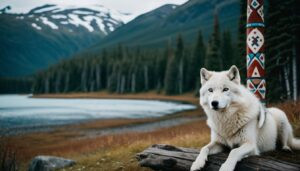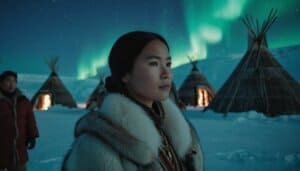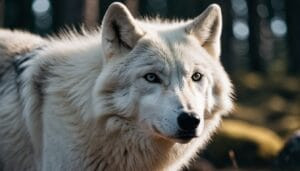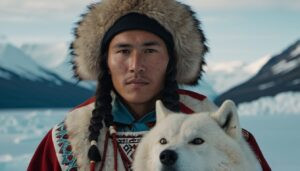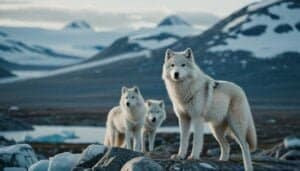Introduction
Legends of Arctic wolves are deeply ingrained in the cultural fabric of Arctic communities, reflecting a profound connection between these majestic creatures and the people of the north. These legends span Inuit and Sami traditions, narrating tales of origin, protection, and spiritual guidance
In Greenland and other Arctic regions, stories of Arctic wolves capture the essence of the harsh environment, revealing insights into human-wolf relationships and the broader natural world
This article delves into the rich tapestry of Arctic wolf legends, exploring their cultural significance, symbolic meanings, and the lessons they impart across generations
Legends of Arctic Wolves in Inuit and Sami Cultures
The rich folklore of Arctic communities is filled with legends about Arctic wolves, especially within Inuit and Sami cultures
These tales often convey deep respect and reverence for the wolves, highlighting their spiritual and symbolic significance. Let’s explore these legends and their various aspects
Origin Stories and Myths
Arctic wolf legends often include origin stories that explain the creation of the world and the role of wolves within it
In Inuit mythology, it is believed that the first wolf was created by the great spirit, a deity responsible for all life in the Arctic. According to one popular tale, the great spirit shaped the wolf from snow and breathed life into it, making the wolf the guardian of the tundra
Sami mythology also contains fascinating origin stories involving wolves. One such story tells of a wolf who was a sacred animal sent by the gods to protect the Sami people. This wolf was said to have special powers, including the ability to communicate with humans and lead them to safety during times of danger
Protective Spirits and Guides
In many Arctic legends, wolves are seen as protective spirits and guides. Among the Inuit, wolves are often depicted as guardians who protect communities from harm. It is believed that the spirits of wolves watch over the people and guide them during difficult times
For example, during long hunting trips, hunters would call upon the spirit of the wolf for protection and guidance, ensuring a successful and safe journey
The Sami also view wolves as spiritual guides. In their folklore, wolves are often depicted as wise and knowledgeable animals that help guide individuals through life. These wolves are believed to possess a deep understanding of the natural world and can provide guidance and support to those who seek it
For instance, during the long winter nights, Sami shamans would enter a trance-like state and communicate with the spirit of the wolf to gain insights and guidance for their community
Symbolism and Spiritual Significance
Arctic wolves hold profound symbolic and spiritual significance in Inuit and Sami cultures. They are often associated with qualities such as strength, endurance, and survival, reflecting the harsh realities of life in the Arctic. The wolf’s ability to thrive in such an unforgiving environment makes it a powerful symbol of resilience and adaptability
Inuit traditions regard the wolf as a symbol of family and community. Wolves are known for their strong social bonds and cooperative hunting strategies, which resonate with the communal values of Inuit society
Stories often emphasize the importance of working together and supporting one another, drawing parallels between wolf packs and human communities
For the Sami, the wolf is a symbol of freedom and independence. Wolves are seen as creatures that roam vast territories, embodying the spirit of the wild. This symbolism is deeply ingrained in Sami culture, where personal freedom and a close connection to nature are highly valued
The wolf’s presence in their legends serves as a reminder of the importance of living in harmony with the natural world
Stories of Cooperation
Legends of Arctic wolves often highlight themes of cooperation between humans and wolves
In many Inuit stories, wolves are depicted as allies who assist humans in their endeavors. One popular legend tells of a hunter who was saved by a pack of wolves after getting lost in a blizzard. The wolves guided him back to his village, showcasing their cooperative nature and willingness to help humans
Similarly, Sami legends frequently feature stories of wolves and humans working together for mutual benefit. In one tale, a Sami hunter befriends a lone wolf and they form a partnership to hunt reindeer. The wolf’s keen senses and the hunter’s skills combine to make them an unstoppable team, illustrating the potential for harmonious coexistence between humans and wolves
These stories of cooperation reflect the deep respect and admiration that Arctic communities have for wolves. They emphasize the importance of mutual support and collaboration, values that are essential for survival in the challenging Arctic environment
Arctic Wolf Legends Across Greenland and the Arctic
Legends of Arctic wolves are not confined to Inuit and Sami cultures; they are also prominent in Greenland and other Arctic regions
These stories reflect the unique environments and cultural contexts of these areas, providing rich narratives that continue to be passed down through generations
Famous Legends and Cultural Significance
Greenland, with its vast icy landscapes, is home to numerous legends involving Arctic wolves. One of the most famous is the story of Qivitoq, the spirit of a person who has ventured into the wilderness and transformed into an animal, often an Arctic wolf
This legend speaks to the deep connection between humans and the wild, emphasizing the wolf’s role as a bridge between the human and natural worlds
Another notable Greenlandic legend tells of the “Wolf Mother,” a mythical wolf that protects lost children. This story highlights the nurturing aspect of wolves, portraying them as compassionate and protective beings. The legend of the Wolf Mother is particularly significant in teaching children about the protective qualities of the wolf and the importance of respecting nature
In addition to Greenland, Arctic wolf legends are also prevalent in other Arctic regions. For example, in Northern Canada, the Dene people have stories of wolves guiding the spirits of the deceased to the afterlife. These legends underscore the spiritual role of wolves, portraying them as guides and protectors in both life and death
Modern Retellings and Interpretations
Modern interpretations of Arctic wolf legends continue to evolve, blending traditional narratives with contemporary themes. In Greenland, artists and storytellers often reinterpret ancient legends to address current issues such as environmental conservation and cultural preservation
For instance, the legend of the Wolf Mother has been adapted into children’s books and educational programs to teach about the importance of protecting Arctic wildlife
In addition, contemporary Inuit and Sami writers and filmmakers have explored wolf legends in their work, using these stories to highlight themes of resilience, community, and identity. These modern retellings serve to keep the legends alive, ensuring that they remain relevant in today’s society while preserving the cultural heritage of Arctic communities
Environmental Reflections
The harsh and unforgiving environment of the Arctic is a common backdrop for many wolf legends. These stories often reflect the challenges of living in such a demanding landscape and the adaptations necessary for survival
The Arctic wolf, with its incredible resilience and ability to thrive in extreme conditions, becomes a powerful symbol of endurance and strength
In Greenlandic and other Arctic legends, the wolf is frequently depicted as a creature that understands the land better than humans. This depiction emphasizes the importance of respecting and learning from nature
For example, one legend tells of a hunter who, after being saved by a wolf, learns to read the signs of the land and weather by observing the wolf’s behavior. This story conveys the lesson that survival in the Arctic depends on harmony with the natural world
The environmental reflections in these legends also highlight the interconnectedness of all living beings. The Arctic wolf is seen as an integral part of the ecosystem, playing a crucial role in maintaining the balance of nature. This perspective fosters a sense of responsibility and stewardship towards the environment, encouraging Arctic communities to protect and preserve their natural heritage
These legends, with their rich environmental themes, serve as a reminder of the delicate balance between humans and nature in the Arctic. They reinforce the idea that the survival of Arctic wolves and the people who share their habitat are intrinsically linked
Human-Wolf Relationships in Arctic Folklore
The intricate relationship between humans and Arctic wolves is a central theme in many Arctic legends
These stories explore the dynamics of coexistence, portraying wolves as both revered and feared creatures. Understanding these narratives offers insights into the cultural values and social structures of Arctic communities
Portrayal in Stories and Legends
In Arctic folklore, the portrayal of wolves often varies between admiration and wariness. Inuit stories frequently depict wolves as noble creatures with qualities that humans aspire to emulate
For instance, the wolf’s loyalty and cooperative spirit are highlighted in tales where wolves work together to protect their pack or aid humans. One well-known Inuit story tells of a young boy who is raised by wolves after being lost in the tundra. The wolves teach him survival skills, and he later returns to his village as a respected hunter, embodying the virtues of courage and wisdom imparted by his wolf family
Conversely, some legends also reflect the fear and respect Arctic communities have for wolves. Sami tales often include warnings about the dangers of crossing paths with wolves or entering their territory
These stories serve as cautionary tales, reminding people of the wolves’ power and the need to respect their space. A famous Sami legend speaks of a hunter who disregards these warnings and suffers dire consequences, ultimately reinforcing the belief that harmony with nature requires acknowledging and respecting the autonomy of wild creatures
Lessons and Morals Taught
Arctic wolf legends are rich with lessons and morals that are integral to the cultural fabric of Arctic communities. These stories often teach values such as cooperation, respect for nature, and the importance of community
In Inuit culture, for example, the wolf’s role in legends as a protector and guide emphasizes the value of mutual aid and collective effort. By working together, both wolves and humans can overcome the harsh challenges posed by the Arctic environment
Sami legends similarly impart crucial life lessons through their wolf narratives. The tales often highlight the balance between independence and interdependence, showcasing how wolves navigate their social structures and natural habitats
One Sami story illustrates this balance through a lone wolf who learns the importance of rejoining its pack to survive a particularly harsh winter, teaching the moral that strength and survival come from unity and cooperation
These moral teachings are often passed down through generations, ensuring that each new generation understands the importance of these values. The stories act as educational tools, embedding cultural wisdom and survival strategies within engaging narratives that resonate with listeners of all ages
Impact on Modern Views and Traditions
The enduring presence of wolf legends in Arctic cultures continues to influence modern views and traditions. Today, these stories play a vital role in cultural preservation and education
Many Arctic communities incorporate wolf legends into their educational curricula, using them to teach children about their heritage, the environment, and essential life skills. This practice helps to keep the legends alive and relevant, bridging the gap between past and present
Moreover, the reverence for wolves reflected in these legends has shaped contemporary attitudes towards wildlife conservation. Arctic communities often advocate for the protection of wolves and their habitats, recognizing the ecological and cultural significance of these animals. Initiatives aimed at preserving Arctic wildlife frequently draw on traditional stories to garner support and raise awareness about the importance of maintaining a balanced ecosystem
In modern literature and media, Arctic wolf legends continue to inspire new works that blend traditional elements with contemporary themes. Authors and filmmakers from Arctic regions often revisit these legends, adapting them to address current issues such as climate change, cultural identity, and environmental stewardship
These adaptations help to ensure that the stories remain dynamic and impactful, fostering a deeper appreciation for the natural world and the rich cultural heritage of Arctic communities
The relationship between humans and wolves in Arctic folklore thus serves as a powerful reminder of the interconnectedness of all life. These legends not only preserve cultural history but also provide valuable lessons for navigating the complexities of the modern world
Conclusion
Legends involving Arctic wolves hold a profound place in the cultural narratives of Arctic communities. These stories, deeply rooted in Inuit and Sami traditions, as well as those from Greenland and other Arctic regions, highlight the wolves’ roles as protectors, guides, and symbols of strength and resilience
From origin myths to tales of cooperation and spiritual significance, Arctic wolf legends teach invaluable lessons about respect for nature, the importance of community, and the balance between independence and interdependence
In modern times, these legends continue to influence and inspire, shaping contemporary views on wildlife conservation and cultural identity. They are preserved and adapted through various mediums, ensuring that the rich heritage and wisdom embedded in these stories endure across generations
The enduring bond between humans and wolves in these legends serves as a testament to the interconnectedness of life and the enduring power of folklore in enriching and guiding human experience



